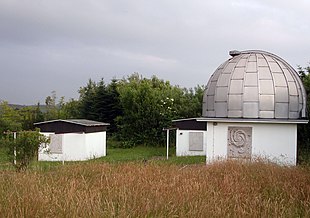Walter Hohmann Observatory
The Walter Hohmann Observatory in the Schuir district of Essen is a public observatory operated by a non-profit association that also participates in planetoid research. It was named in memory of the space pioneer Walter Hohmann . The observatory is located at 120 m above sea level. NN .
history
The observatory was founded in 1965 by a small group of people interested in astronomy and the sponsoring association was entered in the register of associations at the Essen District Court in 1969. Since 1971 the observatory has been called Walter-Hohmann-Sternwarte Essen eV
One of the statutory tasks of the association is to impart astronomical knowledge to everyone through generally understandable lectures and demonstrations on the telescopes . The members of the association carry out sky observations and are particularly active in the field of astrophotography . Public tours are regularly held at the observatory on Wednesday and Friday evenings after dark, but no earlier than 8 p.m.
Minor planets have been observed regularly at the Walter Hohmann Observatory since 1998 . The data are passed on to the Minor Planet Center of the International Astronomical Union (IAU) and are used to calculate the orbital data of the celestial bodies. Since 2002, eleven new minor planets have been discovered at the observatory and three lost planets have been found again.
Members of the WHS work in the field of radio astronomy. The club has a system for recording meteor events with the help of meteor scatters . For this purpose, radio waves from a special transmitter in Belgium are evaluated and promptly displayed on the association's website. A biconical antenna with Callisto reception position records the solar activity in the radio wave range between 20 and 80 MHz. With a loop antenna as part of a longitudinal wave receiver, solar activity is registered indirectly in the gamma ray range and visualized on the local website. The radio telescope with a 3 meter parabolic antenna is designed to receive radiation in the 21 cm wavelength range.
Namesake Walter Hohmann
Walter Hohmann was born the son of a doctor and from 1891 attended the humanistic grammar school in Würzburg , where he graduated from high school in 1900. He studied civil engineering at the Technical University in Munich and from 1904 worked as a test engineer for structural engineering in Vienna, Berlin, Hanover and Wroclaw. From 1912 he worked as a town planning officer and head of the structural department of the building authorities and the material testing center of the city of Essen. Here he died in a hospital on March 11, 1945 shortly before the end of the war. His honorary grave is in the cemetery on Meisenburgstrasse in Bredeney .
In his free time he devoted himself to celestial mechanical calculations, which he published in 1920 in his work The Accessibility of Heavenly Bodies. He developed basic principles of space travel and created elementary prerequisites for conquering space. His ideas were taken up for the Apollo program and the Voyager space probes, among others. Today he is considered a trailblazer and pioneer in space travel.
In recognition of his scientific achievements, a moon crater was named after him in 1970. The Essen Astronomical Working Group named itself Walter Hohmann Observatory in 1971.
Instruments
The telescopes of the observatory are housed in a dome and in four observation stations with sliding roofs. In the premises of the former school of Schuir there is a lecture room with 45 seats and modern projection technology, as well as mechanical, electrical and optical workshops. There is also a small library with astronomical literature on the upper floor. These rooms and the telescopes are available to members of the working group for their work.
- The main instrument is a Nasmyth telescope with a main mirror diameter of 56 cm and a focal length of 7 m on a fork mount. A 12.5 cm telescope of the Fraunhofer type with a focal length of 1.8 m serves as a guide telescope . The computer-controlled instrument was designed and built by the consortium. It is housed in the dome.
- In 2009 the second largest telescope in the observatory was inaugurated, namely a Newtonian reflector telescope optimized for photography. The diameter of the objective mirror is 41 cm.
- A Schmidt-Cassegrain telescope with a main mirror diameter of 35 cm and a focal length of 3.5 m is particularly suitable for observing the moon and planets . The instrument was procured in 2016.
- The Newtonian telescope with 31.5 cm main mirror and a focal length of 1.80 m is mainly used for astrophotography and the photography of minor planets .
- In addition, an apochromatic 15 cm refractor with a 1.3 m focal length as well as various transportable instruments such as Schmidt-Cassegrain telescopes are available.
- A radio telescope with a parabolic antenna 3 m in diameter is used to observe the sun, the planet Jupiter and the Milky Way in the radio wave range.
Web links
Coordinates: 51 ° 23 ′ 37.5 " N , 6 ° 58 ′ 42.4" E





